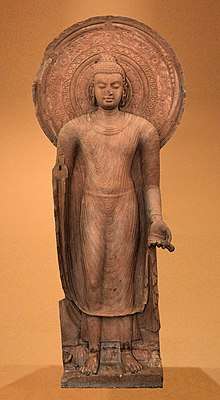Gupta Empire
The Gupta Empire was an ancient Indian empire existing from the mid-to-late 3rd century CE to 543 CE. At its zenith, from approximately 319 to 467 CE, it covered much of the Indian subcontinent.[4] This period is considered as the Golden Age of India by some historians.[5][note 1] The ruling dynasty of the empire was founded by the king Sri Gupta; the most notable rulers of the dynasty were Chandragupta I, Samudragupta, and Chandragupta II alias Vikramaditya. The 5th-century CE Sanskrit poet Kalidasa credits the Guptas with having conquered about twenty-one kingdoms, both in and outside India, including the kingdoms of Parasikas, the Hunas, the Kambojas, tribes located in the west and east Oxus valleys, the Kinnaras, Kiratas, and others.[7]
Gupta Empire | |||||||||||||||||||||||||
|---|---|---|---|---|---|---|---|---|---|---|---|---|---|---|---|---|---|---|---|---|---|---|---|---|---|
| 3rd century CE–543 CE | |||||||||||||||||||||||||
 Approximate extent of the Gupta territories (purple) in 375 CE. | |||||||||||||||||||||||||
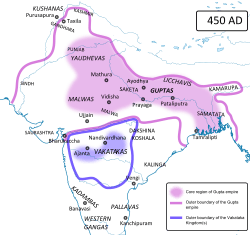 Approximate extent of the Gupta territories (purple) in 450 CE. | |||||||||||||||||||||||||
| Capital | Pataliputra | ||||||||||||||||||||||||
| Common languages | Sanskrit (literary and academic); Prakrit (vernacular) | ||||||||||||||||||||||||
| Religion | |||||||||||||||||||||||||
| Government | Monarchy | ||||||||||||||||||||||||
• c. late 3rd century | Gupta(first) | ||||||||||||||||||||||||
• c. 540 – c. 550 CE | Vishnugupta | ||||||||||||||||||||||||
| Historical era | Ancient India | ||||||||||||||||||||||||
• Established | 3rd century CE | ||||||||||||||||||||||||
• Disestablished | 543 CE | ||||||||||||||||||||||||
| Area | |||||||||||||||||||||||||
| 400 est.[1] | 3,500,000 km2 (1,400,000 sq mi) | ||||||||||||||||||||||||
| 440 est.[2] | 1,700,000 km2 (660,000 sq mi) | ||||||||||||||||||||||||
| |||||||||||||||||||||||||
| Today part of | India Pakistan Bangladesh Myanmar Afghanistan[3] | ||||||||||||||||||||||||
The high points of this period are the great cultural developments which took place primarily during the reigns of Samudragupta, Chandragupta II and Kumaragupta I. Many of the literary sources, such as Mahabharata and Ramayana, were canonised during this period.[8] The Gupta period produced scholars such as Kalidasa,[9] Aryabhata, Varahamihira, and Vatsyayana who made great advancements in many academic fields.[10][11][12] Science and political administration reached new heights during the Gupta era.[11] The period gave rise to achievements in architecture, sculpture, and painting that "set standards of form and taste [that] determined the whole subsequent course of art, not only in India but far beyond her borders".[13] Strong trade ties also made the region an important cultural centre and established the region as a base that would influence nearby kingdoms and regions in South Asia and Southeast Asia.[14] The Puranas, earlier long poems on a variety of subjects, are also thought to have been committed to written texts around this period.[13][3]
The empire eventually died out because of many factors such as substantial loss of territory and imperial authority caused by their own erstwhile feudatories, as well as the invasion by the Huna peoples (Kidarites and Alchon Huns) from Central Asia.[15][16] After the collapse of the Gupta Empire in the 6th century, India was again ruled by numerous regional kingdoms.
Origin
| Gupta Empire 320 CE–550 CE | ||||||||||||||||||||||||||||||||||||
|---|---|---|---|---|---|---|---|---|---|---|---|---|---|---|---|---|---|---|---|---|---|---|---|---|---|---|---|---|---|---|---|---|---|---|---|---|
|
||||||||||||||||||||||||||||||||||||
The homeland of the Guptas is uncertain.[17] According to one theory, they originated in the present-day lower-doab[18] region of Uttar Pradesh, where most of the inscriptions and coin hoards of the early Gupta kings have been discovered.[19][20] This theory is also supported by the Purana, as argued by the proponents, that mention the territory of the early Gupta kings as Prayaga, Saketa, and Magadha areas in the Ganges basin.[21][22]
Another prominent theory locates the Gupta homeland in the present-day Bengal region, based on the account of the 7th century Chinese Buddhist monk Yijing. According to Yijing, king Che-li-ki-to (identified with the dynasty's founder Shri Gupta) built a temple for Chinese pilgrims near Mi-li-kia-si-kia-po-no (apparently a transcription of Mriga-shikha-vana). Yijing states that this temple was located more than 40 yojanas east of Nalanda, which would mean it was situated somewhere in the modern Bengal region.[23] Another proposal is that the early Gupta kingdom extended from Prayaga in the west to northern Bengal in the east.[24]
The Gupta records do not mention the dynasty's varna (social class).[25] Some historians, such as A.S. Altekar, have theorised that they were of Vaishya origin, as certain ancient Indian texts prescribe the name "Gupta" for the members of the Vaishya varna.[26][27] According to historian R. S. Sharma, the Vaishyas – who were traditionally associated with trade – may have become rulers after resisting oppressive taxation by the previous rulers.[28] Critics of the Vaishya-origin theory point out that the suffix Gupta features in the names of several non-Vaishyas before as well as during the Gupta period,[29] and the dynastic name "Gupta" may have simply derived from the name of the family's first king Gupta.[30] Some scholars, such as S.R. Goyal, theorise that the Guptas were Brahmanas, because they had matrimonial relations with Brahmanas, but others reject this evidence as inconclusive.[31] Based on the Pune and Riddhapur inscriptions of the Gupta princess Prabhavati-gupta, some scholars believe that the name of her paternal gotra (clan) was "Dharana", but an alternative reading of these inscriptions suggests that Dharana was the gotra of her mother Kuberanaga.[32]
History
Early rulers

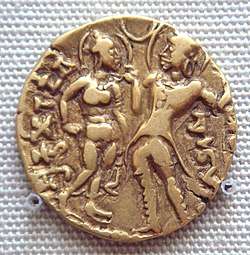
Gupta (Gupta script: ![]()
![]()
In the Allahabad Pillar inscription, Gupta and his successor Ghatotkacha are described as Maharaja ("great king"), while the next king Chandragupta I is called a Maharajadhiraja ("king of great kings"). In the later period, the title Maharaja was used by feudatory rulers, which has led to suggestions that Gupta and Ghatotkacha were vassals (possibly of Kushan Empire).[38] However, there are several instances of paramount sovereigns using the title Maharaja, in both pre-Gupta and post-Gupta periods, so this cannot be said with certainty. That said, there is no doubt that Gupta and Ghatotkacha held a lower status and were less powerful than Chandragupta I.[39]
Chandragupta I married the Lichchhavi princess Kumaradevi, which may have helped him extend his political power and dominions, enabling him to adopt the imperial title Maharajadhiraja.[40] According to the dynasty's official records, he was succeeded by his son Samudragupta. However, the discovery of the coins issued by a Gupta ruler named Kacha have led to some debate on this topic: according to one theory, Kacha was another name for Samudragupta; another possibility is that Kacha was a rival claimant to the throne.[41]
Samudragupta
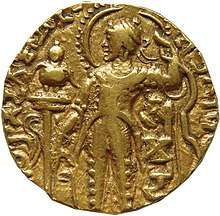
Samudragupta succeeded his father around 335 or 350 CE, and ruled until c. 375 CE.[42] The Allahabad Pillar inscription, composed by his courtier Harishena, credits him with extensive conquests.[43] The inscription asserts that Samudragupta uprooted 8 kings of Aryavarta, the northern region, including the Nagas.[44] It further claims that he subjugated all the kings of the forest region, which was most probably located in central India.[45] It also credits him with defeating 12 rulers of Dakshinapatha, the southern region: the exact identification of several of these kings is debated among modern scholars,[46] but it is clear that these kings ruled areas located on the eastern coast of India.[47] The inscription suggests that Samudragupta advanced as far as the Pallava kingdom in the south, and defeated Vishnugopa, the Pallava regent of Kanchi.[48] During this southern campaign, Samudragupta most probably passed through the forest tract of central India, reached the eastern coast in present-day Odisha, and then marched south along the coast of Bay of Bengal.[49]
The Allahabad Pillar inscription mentions that rulers of several frontier kingdoms and tribal oligarchies paid Samudragupta tributes, obeyed his orders, and performed obeisance before him.[50][51] The frontier kingdoms included Samatata, Davaka, Kamarupa, Nepala, and Karttripura.[52] The tribal oligarchies included Malavas, Arjunayanas, Yaudheyas, Madrakas, and Abhiras, among others.[51]
Finally, the inscription mentions that several foreign kings tried to please Samudragupta by personal attendance; offered him their daughters in marriage (or according to another interpretation, gifted him maidens[53]); and sought the use of the Garuda-depicting Gupta seal for administering their own territories.[54] This is an exaggeration: for example, the inscription lists the king of Simhala among these kings. It is known that from Chinese sources that the Simhala king Meghavarna sent rich presents to the Gupta king requesting his permission to build a Buddhist monastery at Bodh Gaya: Samudragupta's pangyerist appears to have described this act of diplomacy as an act of subservience.[55]
Samudragupta appears to have been Vaishnavite, as attested by his Eran inscription,[56][57] and performed several Brahmanical ceremonies.[58] The Gupta records credit him with making generous donations of cows and gold.[56] He performed the Ashvamedha ritual (horse sacrifice), which was used by the ancient Indian kings to prove their imperial sovereignty, and issued gold coins (see Coinage below) to mark this performance.[59]
The Allahabad Pillar inscription presents Samudragupta as a wise king and strict administrator, who was also compassionate enough to help the poor and the helpless.[60] It also alludes to the king's talents as a musician and a poet, and calls him the "king of poets".[61] Such claims are corroborated by Samudragupta's gold coins, which depict him playing a veena.[62]
Samudragupta appears to have directly controlled a large part of the Indo-Gangetic Plain in present-day India, as well as a substantial part of central India.[63] Besides, his empire comprised a number of monarchical and tribal tributary states of northern India, and of the south-eastern coastal region of India.[64][47]
Ramagupta
Although, the narrative of the Devichandragupta is not supported by any contemporary epigraphical evidence, the historicity of Rama Gupta is proved by his Durjanpur inscriptions on three Jaina images, where he is mentioned as the Maharajadhiraja. A large number of his copper coins also have been found from the Eran-Vidisha region and classified in five distinct types, which include the Garuda,[66] Garudadhvaja, lion and border legend types. The Brahmi legends on these coins are written in the early Gupta style.[67]
Chandragupta II "Vikramaditya"

According to the Gupta records, amongst his sons, Samudragupta nominated prince Chandragupta II, born of queen Dattadevi, as his successor. Chandragupta II, Vikramaditya (the Sun of Power), ruled from 375 until 415. He married a Kadamba princess of Kuntala and of Naga lineage (Nāgakulotpannnā), Kuberanaga. His daughter Prabhavatigupta from this Naga queen was married to Rudrasena II, the Vakataka ruler of Deccan.[68] His son Kumaragupta I was married to a Kadamba princess of the Karnataka region. Chandragupta II expanded his realm westwards, defeating the Saka Western Kshatrapas of Malwa, Gujarat and Saurashtra in a campaign lasting until 409. His main opponent Rudrasimha III was defeated by 395, and he crushed the Bengal chiefdoms. This extended his control from coast to coast, established a second capital at Ujjain and was the high point of the empire.

Despite the creation of the empire through war, the reign is remembered for its very influential style of Hindu art, literature, culture and science, especially during the reign of Chandragupta II. Some excellent works of Hindu art such as the panels at the Dashavatara Temple in Deogarh serve to illustrate the magnificence of Gupta art. Above all, it was the synthesis of elements that gave Gupta art its distinctive flavour. During this period, the Guptas were supportive of thriving Buddhist and Jain cultures as well, and for this reason, there is also a long history of non-Hindu Gupta period art. In particular, Gupta period Buddhist art was to be influential in most of East and Southeast Asia. Many advances were recorded by the Chinese scholar and traveller Faxian in his diary and published afterwards.
The court of Chandragupta was made even more illustrious by the fact that it was graced by the Navaratna (Nine Jewels), a group of nine who excelled in the literary arts. Amongst these men was Kālidāsa, whose works dwarfed the works of many other literary geniuses, not only in his own age but in the years to come. Kalidasa was mainly known for his subtle exploitation of the shringara (romantic) element in his verse.
Chandragupta II's campaigns against foreign tribes
The 4th century Sanskrit poet Kalidasa credits Chandragupta Vikramaditya with conquering about twenty-one kingdoms, both in and outside India. After finishing his campaign in East and West India, Vikramaditya (Chandragupta II) proceeded northwards, subjugated the Parasikas, then the Hunas and the Kambojas tribes located in the west and east Oxus valleys respectively. Thereafter, the king proceeded into the Himalaya mountains to reduce the mountain tribes of the Kinnaras, Kiratas, as well as India proper.[7]
The Brihatkathamanjari of the Kashmiri writer Kshemendra states, King Vikramaditya (Chandragupta II) had "unburdened the sacred earth of the Barbarians like the Sakas, Mlecchas, Kambojas, Yavanas, Tusharas, Parasikas, Hunas, and others, by annihilating these sinful Mlecchas completely".[69][70][71]
Faxian
Faxian (or Fa Hsien etc.), a Chinese Buddhist, was one of the pilgrims who visited India during the reign of the Gupta emperor Chandragupta II. He started his journey from China in 399 and reached India in 405. During his stay in India up to 411, he went on a pilgrimage to Mathura, Kannauj, Kapilavastu, Kushinagar, Vaishali, Pataliputra, Kashi, and Rajagriha, and made careful observations about the empire's conditions. Faxian was pleased with the mildness of administration. The Penal Code was mild and offences were punished by fines only. From his accounts, the Gupta Empire was a prosperous period. And until the Rome–China trade axis was broken with the fall of the Han dynasty, the Guptas did indeed prosper. His writings form one of the most important sources for the history of this period.[72]
Faxian on reaching Mathura comments––
"The snow and heat are finely tempered, and there is neither hoarfrost nor snow. The people are numerous and happy. They have not to register their households. Only those who cultivate the royal land have to pay (a portion of) the gain from it. If they want to go, they go. If they want to stay on, they stay on. The king governs without decapitation or (other) corporal punishments. Criminals are simply fined according to circumstances. Even in cases of repeated attempts at wicked rebellion, they only have their right-hand cut off. The king's bodyguards & attendants all have salaries. Throughout the whole country, the people do not kill any living creature, not drink any intoxicating liquor, nor eat onions or garlic." [72]
Kumaragupta I
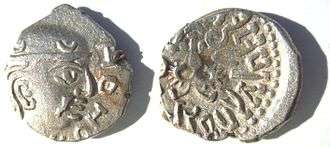
Obv: Bust of king with crescents, with traces of corrupt Greek script.[73][74]
Rev: Garuda standing facing with spread wings. Brahmi legend: Parama-bhagavata rajadhiraja Sri Kumaragupta Mahendraditya.
Chandragupta II was succeeded by his second son Kumaragupta I, born of Mahadevi Dhruvasvamini. Kumaragupta I assumed the title, Mahendraditya.[75] He ruled until 455. Towards the end of his reign a tribe in the Narmada valley, the Pushyamitras, rose in power to threaten the empire. The Kidarites as well probably confronted the Gupta Empire towards the end of the rule of Kumaragupta I, as his son Skandagupta mentions in the Bhitari pillar inscription his efforts at reshaping a country in disarray, through reorganisation and military victories over the Pushyamitras and the Hunas.[76]
He was the founder of Nalanda University which on 15 July 2016 was declared as a UNESCO world heritage site.[77]
Skandagupta
Skandagupta, son and successor of Kumaragupta I is generally considered to be the last of the great Gupta rulers. He assumed the titles of Vikramaditya and Kramaditya.[78] He defeated the Pushyamitra threat, but then was faced with invading Kidarites (sometimes described as the Hephthalites or "White Huns", known in India as the Sweta Huna), from the northwest.
He repelled a Huna attack around 455 CE, but the expense of the wars drained the empire's resources and contributed to its decline. The Bhitari Pillar inscription of Skandagupta, the successor of Chandragupta, recalls the near-annihilation of the Gupta Empire following the attacks of the Kidarites.[79] The Kidarites seem to have retained the western part of the Gupta Empire.[79]
Skandagupta died in 467 and was succeeded by his agnate brother Purugupta.[80]
Decline of the empire
Following Skandagupta's death, the empire was clearly in decline,[81] and the later Gupta coinage indicates their loss of control over much of western India after 467–469.[4] Skandagupta was followed by Purugupta (467–473), Kumaragupta II (473–476), Budhagupta (476–495), Narasimhagupta (495—530), Kumaragupta III (530—540), Vishnugupta (540—550), two lesser known kings namely, Vainyagupta and Bhanugupta.
In the 480's the Alchon Huns under Toramana and Mihirakula broke through the Gupta defences in the northwest, and much of the empire in the northwest was overrun by the Huns by 500. According to some scholars the empire disintegrated under the attacks of Toramana and his successor Mihirakula.[82][83] It appears from inscriptions that the Guptas, although their power was much diminished, continued to resist the Huns. The Hun invader Toramana was defeated by Bhanugupta in 510.[84][85] The Huns were defeated and driven out of India in 528 by King Yashodharman from Malwa, and possibly Gupta emperor Narasimhagupta.[86]
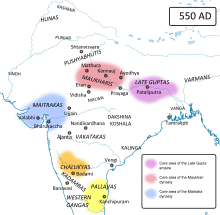
These invasions, although only spanning a few decades, had long term effects on India, and in a sense brought an end to Classical Indian civilisation.[87] Soon after the invasions, the Gupta Empire, already weakened by these invasions and the rise of local rulers such as Yashodharman, ended as well.[88] Following the invasions, northern India was left in disarray, with numerous smaller Indian powers emerging after the crumbling of the Guptas.[89] The Huna invasions are said to have seriously damaged India's trade with Europe and Central Asia.[87] In particular, Indo-Roman trade relations, which the Gupta Empire had greatly benefited from. The Guptas had been exporting numerous luxury products such as silk, leather goods, fur, iron products, ivory, pearl, and pepper from centres such as Nasik, Paithan, Pataliputra, and Benares. The Huna invasion probably disrupted these trade relations and the tax revenues that came with them.[90]
Furthermore, Indian urban culture was left in decline, and Buddhism, gravely weakened by the destruction of monasteries and the killing of monks by the hand of the vehemently anti-Buddhist Shaivist Mihirakula, started to collapse.[87] Great centres of learning were destroyed, such as the city of Taxila, bringing cultural regression.[87] During their rule of 60 years, the Alchons are said to have altered the hierarchy of ruling families and the Indian caste system. For example, the Hunas are often said to have become the precursors of the Rajputs.[87]
The succession of the 6th-century Guptas is not entirely clear, but the tail end recognised ruler of the dynasty's main line was king Vishnugupta, reigning from 540 to 550. In addition to the Hun invasion, the factors, which contribute to the decline of the empire include competition from the Vakatakas and the rise of Yashodharman in Malwa.[91]

The last known inscription by a Gupta emperor is from the reign of Vishnugupta (the Damodarpur copper-plate inscription),[93] in which he makes a land grant in the area of Kotivarsha (Bangarh in West Bengal) in 542/543 CE.[94] This follows the occupation of most of northern and central India by the Aulikara ruler Yashodharman circa 532 CE.[94]
A 2019 study by archaeologist Shanker Sharma has concluded that the cause of the Gupta empire's downfall was a devastating flood which happened around the middle of the 6th century in Uttar Pradesh and Bihar.[95]
Post-Gupta successor dynasties
In the heart of the former Gupta Empire, in the Gangetic region, the Guptas were succeeded by the Maukhari dynasty and the Pushyabhuti dynasty.[96] The coinage of the Maukharis and Pushyabhutis followed the silver coin type of the Guptas, with portrait of the ruler in profile (although facing in the reverse direction compared to the Guptas, a possible symbol of antagonism)[92] and the peacock on the reverse, the Brahmi legend being kept except for the name of the ruler.[96]
In the western regions, they were succeeded by the Gurjaras, the Pratiharas, and later the Chaulukya-Paramara dynasties, who issued so-called Indo-Sasanian coinage, on the model of the coinage of the Sasanian Empire, which had been introduced in India by the Alchon Huns.[96]
Military organization
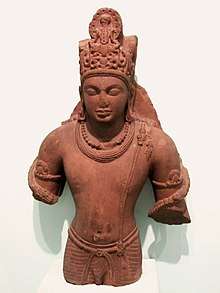
In contrast to the Mauryan Empire, the Guptas introduced several military innovations to Indian warfare. Chief amongst these was the use of heavy cavalry archers and heavy sword cavalry. The heavy cavalry formed the core of the Gupta army and were supported by the traditional Indian army elements of elephants and light infantry.[97]
The utilisation of horse archers in the Gupta period is evidenced on the coinage of Chandragupta II, Kumaragupta I and Prakasaditya (postulated to be Purugupta[98]) that depicts the emperors as horse-archers.[99][100]
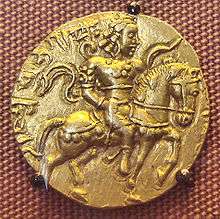
Unfortunately there is a paucity of contemporary sources detailing the tactical operations of the Imperial Gupta Army. The best extant information comes from the Sanskrit mahakavya (epic poem) Raghuvaṃśa written by the Classical Sanskrit writer and dramatist Kalidasa. Many modern scholars put forward the view that Kalidasa lived from the reign of Chandragupta II to the reign of Skandagupta[102][103][104][105] and that the campaigns of Raghu – his protagonist in the Raghuvaṃśa – reflect those of Chandragupta II.[106] In Canto IV of the Raghuvamsa, Kalidasa relates how the king's forces clash against the powerful, cavalry-centric, forces of the Persians and later the Yavanas (probably Huns) in the North-West. Here he makes special mention of the use horse-archers in the kings army and that the horses needed much rest after the hotly contested battles.[107] The five arms of the Gupta military included infantry, cavalry, chariot, elephants and ships. Gunaighar copper plate inscription of Vainya Gupta mentions ships but not chariots.[108] Ships had become integral part of Indian military in the 6th century AD.
Religion
.jpg)
The Guptas were traditionally a Hindu dynasty.[109] They were orthodox Hindus, but did not force their beliefs on the rest of the population, as Buddhism and Jainism also were encouraged.[110] Sanchi remained an important centre of Buddhism.[110] Kumaragupta I (c. 414 – c. 455 CE) is said to have founded Nalanda.[110]
Some later rulers however seem to have especially favoured Buddhism. Narasimhagupta Baladitya (c. 495–?), according to contemporary writer Paramartha, was brought up under the influence of the Mahayanist philosopher, Vasubandhu.[109] He built a sangharama at Nalanda and also a 300 ft (91 m) high vihara with a Buddha statue within which, according to Xuanzang, resembled the "great Vihara built under the Bodhi tree". According to the Manjushrimulakalpa (c. 800 CE), king Narasimhsagupta became a Buddhist monk, and left the world through meditation (Dhyana).[109] The Chinese monk Xuanzang also noted that Narasimhagupta Baladitya's son, Vajra, who commissioned a sangharama as well, "possessed a heart firm in faith".[111]:45[112]:330
Gupta administration
A study of the epigraphical records of the Gupta empire shows that there was a hierarchy of administrative divisions from top to bottom. The empire was called by various names such as Rajya, Rashtra, Desha, Mandala, Prithvi and Avani. It was divided into 26 provinces, which were styled as Bhukti, Pradesha and Bhoga. Provinces were also divided into Vishayas and put under the control of the Vishayapatis. A Vishayapati administered the Vishaya with the help of the Adhikarana (council of representatives), which comprised four representatives: Nagarasreshesthi, Sarthavaha, Prathamakulika and Prathama Kayastha. A part of the Vishaya was called Vithi.[113] The Gupta also had trading links with the Sassanid and Byzantine Empire.
Legacy

Scholars of this period include Varahamihira and Aryabhata, who is believed to be the first to come up with the concept of zero, postulated the theory that the Earth moves round the Sun, and studied solar and lunar eclipses. Kalidasa, who was a great playwright, who wrote plays such as Shakuntala, and marked the highest point of Sanskrit literature is also said to have belonged to this period. The Sushruta Samhita, which is a Sanskrit redaction text on all of the major concepts of ayurvedic medicine with innovative chapters on surgery, dates to the Gupta period.
Chess is said to have developed in this period,[114] where its early form in the 6th century was known as caturaṅga, which translates as "four divisions [of the military]" – infantry, cavalry, elephantry, and chariotry – represented by the pieces that would evolve into the modern pawn, knight, bishop, and rook, respectively. Doctors also invented several medical instruments, and even performed operations. The Indian numerals which were the first positional base 10 numeral systems in the world originated from Gupta India. The names of the seven days in a week appeared at the start of the Gupta period based on Hindu deities and planets corresponding to the Roman names. The ancient Gupta text Kama Sutra by the Indian scholar Vatsyayana is widely considered to be the standard work on human sexual behaviour in Sanskrit literature.
Aryabhata, a noted mathematician-astronomer of the Gupta period proposed that the earth is round and rotates about its own axis. He also discovered that the Moon and planets shine by reflected sunlight. Instead of the prevailing cosmogony in which eclipses were caused by pseudo-planetary nodes Rahu and Ketu, he explained eclipses in terms of shadows cast by and falling on Earth.[115]
Art and architecture
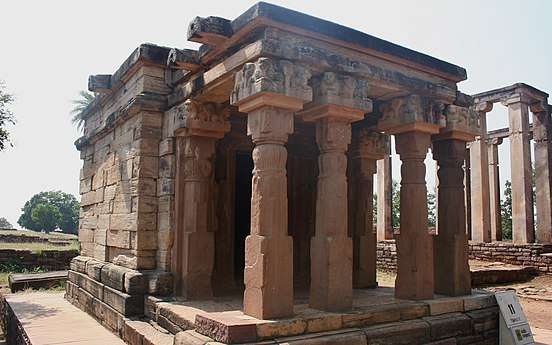 A tetrastyle prostyle Gupta period temple at Sanchi besides the Apsidal hall with Maurya foundation, an example of Buddhist architecture. 5th century CE.
A tetrastyle prostyle Gupta period temple at Sanchi besides the Apsidal hall with Maurya foundation, an example of Buddhist architecture. 5th century CE.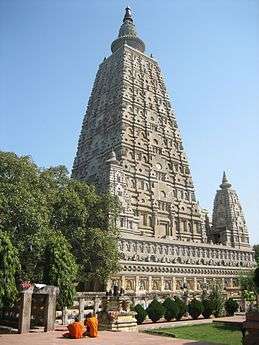 The current structure of the Mahabodhi Temple dates to the Gupta era, 5th century CE. Marking the location where the Buddha is said to have attained enlightenment.
The current structure of the Mahabodhi Temple dates to the Gupta era, 5th century CE. Marking the location where the Buddha is said to have attained enlightenment. Dashavatara Temple is a Vishnu Hindu temple built during the Gupta period.
Dashavatara Temple is a Vishnu Hindu temple built during the Gupta period.
The Gupta period is generally regarded as a classic peak of North Indian art for all the major religious groups. Although painting was evidently widespread, the surviving works are almost all religious sculpture. The period saw the emergence of the iconic carved stone deity in Hindu art, as well as the Buddha-figure and Jain tirthankara figures, the latter often on a very large scale. The two great centres of sculpture were Mathura and Gandhara, the latter the centre of Greco-Buddhist art. Both exported sculpture to other parts of northern India.
The most famous remaining monuments in a broadly Gupta style, the caves at Ajanta, Elephanta, and Ellora (respectively Buddhist, Hindu, and mixed including Jain) were in fact produced under later dynasties, but primarily reflect the monumentality and balance of Guptan style. Ajanta contains by far the most significant survivals of painting from this and the surrounding periods, showing a mature form which had probably had a long development, mainly in painting palaces.[116] The Hindu Udayagiri Caves actually record connections with the dynasty and its ministers,[117] and the Dashavatara Temple at Deogarh is a major temple, one of the earliest to survive, with important sculpture.[118]

 Buddha from Sarnath, 5–6th century CE
Buddha from Sarnath, 5–6th century CE The Colossal trimurti at the Elephanta Caves
The Colossal trimurti at the Elephanta Caves
- Nalrajar Garh fortification wall is one of the last surviving fortification remains from the Gupta period currently 5–7 m high
 Nalanda university was first established under Gupta empire
Nalanda university was first established under Gupta empire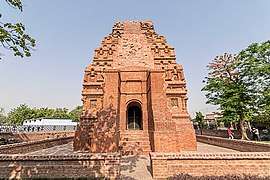 Bitargaon temple from the Gupta period provide one of the earliest examples of pointed arches any where in the world
Bitargaon temple from the Gupta period provide one of the earliest examples of pointed arches any where in the world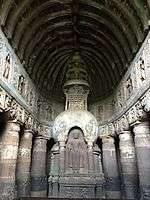 Ajanta caves from Gupta era
Ajanta caves from Gupta era- Krishna fighting the horse demon Keshi, 5th century
References
Part of a series on the |
|---|
| History of India |
Satavahana gateway at Sanchi, 1st century CE |
|
Ancient
|
|
Classical
|
|
|
|
Early modern
|
|
Modern
|
|
Related articles
|
- Turchin, Peter; Adams, Jonathan M.; Hall, Thomas D (December 2006). "East-West Orientation of Historical Empires". Journal of World-Systems Research. 12 (2): 223. doi:10.5195/JWSR.2006.369. ISSN 1076-156X.
- Taagepera, Rein (1979). "Size and Duration of Empires: Growth-Decline Curves, 600 B.C. to 600 A.D". Social Science History. 3 (3/4): 121. doi:10.2307/1170959. JSTOR 1170959.
- Dikshitar, V. R. Ramachandra (1993). The Gupta Polity. Motilal Banarsidass Publ. ISBN 978-81-208-1024-2.
- Gupta Dynasty – MSN Encarta. Archived from the original on 29 October 2009.
- N. Jayapalan, History of India, Vol. I, (Atlantic Publishers, 2001), 130.
- Jha, D.N. (2002). Ancient India in Historical Outline. Delhi: Manohar Publishers and Distributors. pp. 149–73. ISBN 978-81-7304-285-0.
- Raghu Vamsa v 4.60–75
- Gupta dynasty (Indian dynasty) Archived 30 March 2010 at the Wayback Machine. Britannica Online Encyclopedia. Retrieved 21 November 2011.
- Keay, John (2000). India: A history. Atlantic Monthly Press. pp. 151–52. ISBN 978-0-87113-800-2.
Kalidasa wrote ... with an excellence which, by unanimous consent, justifies the inevitable comparisons with Shakespeare ... When and where Kalidasa lived remains a mystery. He acknowledges no links with the Guptas; he may not even have coincided with them ... but the poet's vivid awareness of the terrain of the entire subcontinent argues strongly for a Guptan provenance.
- Vidya Dhar Mahajan 1990, p. 540.
- Keay, John (2000). India: A history. Atlantic Monthly Press. p. 132. ISBN 978-0-87113-800-2.
The great era of all that is deemed classical in Indian literature, art and science was now dawning. It was this crescendo of creativity and scholarship, as much as ... political achievements of the Guptas, which would make their age so golden.
- Gupta dynasty: empire in 4th century Archived 30 March 2010 at the Wayback Machine. Britannica Online Encyclopedia. Retrieved 21 November 2011.
- J.C. Harle 1994, p. 87.
- Trade | The Story of India – Photo Gallery Archived 28 March 2010 at the Wayback Machine. PBS. Retrieved 21 November 2011.
- Ashvini Agrawal 1989, pp. 264–69.
- Grousset, Rene (1970). The Empire of the Steppes. Rutgers University Press. p. 69. ISBN 978-0-8135-1304-1.
- Ashvini Agrawal 1989, p. 79.
- Dani, Ahmad Hasan; Litvinsky, B. A. (1996). History of Civilizations of Central Asia: The crossroads of civilizations, A.D. 250 to 750. UNESCO. p. 185. ISBN 978-92-3-103211-0.
On the basis of...historians have now come to accept the lower doab region as the original homeland of the Guptas.
- Dilip Kumar Ganguly 1987, p. 14.
- Tej Ram Sharma 1989, p. 39.
- Dilip Kumar Ganguly 1987, p. 2.
- Ashvini Agrawal 1989, p. 96.
- Dilip Kumar Ganguly 1987, pp. 7–11.
- Dilip Kumar Ganguly 1987, p. 12.
- Tej Ram Sharma 1989, p. 44.
- Ashvini Agrawal 1989, p. 82.
- Tej Ram Sharma 1989, p. 42.
- R. S. Sharma (2003). Early Medieval Indian Society: A Study in Feudalisation. Orient Longman. ISBN 9788125025238.
- R.C. Majumdar 1981, p. 4.
- Tej Ram Sharma 1989, p. 40.
- Tej Ram Sharma 1989, pp. 43–44.
- Ashvini Agrawal 1989, p. 83.
- Full inscription, Fleet, John Faithfull (1888). Corpus Inscriptionum Indicarum Vol. 3. pp. 1–17.
- Tej Ram Sharma 1989, pp. 49–55.
- Ashvini Agrawal 1989, p. 86.
- Ashvini Agrawal 1989, pp. 84–85.
- Ashvini Agrawal 1989, pp. 79–81.
- Ashvini Agrawal 1989, p. 85.
- R.C. Majumdar 1981, pp. 6–7.
- R.C. Majumdar 1981, p. 10.
- Tej Ram Sharma 1989, p. 71.
- Tej Ram Sharma 1989, pp. 51–52.
- Ashvini Agrawal 1989, pp. 106–07.
- Ashvini Agrawal 1989, p. 114.
- Ashvini Agrawal 1989, p. 117.
- Ashvini Agrawal 1989, p. 107.
- Ashvini Agrawal 1989, p. 112.
- Ashvini Agrawal 1989, p. 110.
- Tej Ram Sharma 1989, pp. 80–81.
- Tej Ram Sharma 1989, p. 84.
- Upinder Singh 2017, p. 343.
- Ashvini Agrawal 1989, pp. 112–18.
- Ashvini Agrawal 1989, p. 125.
- Shankar Goyal 2001, p. 168.
- Tej Ram Sharma 1989, p. 90.
- Tej Ram Sharma 1989, p. 68.
- R.C. Majumdar 1981, p. 32.
- Tej Ram Sharma 1989, p. 91.
- Ashvini Agrawal 1989, pp. 125–26.
- Tej Ram Sharma 1989, pp. 91, 94.
- R.C. Majumdar 1981, p. 31.
- Tej Ram Sharma 1989, p. 94.
- R.C. Majumdar 1981, pp. 23, 27.
- R.C. Majumdar 1981, p. 22.
- Smith, Vincent Arthur (1911). A history of fine art in India and Ceylon, from the earliest times to the present day. Oxford: Clarendon Press. pp. 170–171.
- Ashvini Agrawal 1989, pp. 153–59.
- Bajpai, K.D. (2004). Indian Numismatic Studies. New Delhi: Abhinav Publications. pp. 120–21. ISBN 978-81-7017-035-8.
- H.C. Raychaudhuri 1923, p. 489.
- ata shrivikramadityo helya nirjitakhilah Mlechchana Kamboja. Yavanan neechan Hunan Sabarbran Tushara. Parsikaanshcha tayakatacharan vishrankhalan hatya bhrubhangamatreyanah bhuvo bharamavarayate (Brahata Katha, 10/1/285-86, Kshmendra).
- Kathasritsagara 18.1.76–78
- Cf:"In the story contained in Kathasarit-sagara, king Vikarmaditya is said to have destroyed all the barbarous tribes such as the Kambojas, Yavanas, Hunas, Tokharas and the, National Council of Teachers of English Committee on Recreational Reading – Sanskrit language.
- Fa-hsien, ca 337-ca 422; Legge, James (1886). A record of Buddhistic kingdoms; being an account by the Chinese monk Fâ-Hien of his travels in India and Ceylon, A.D. 399-414, in search of the Buddhist books of discipline. Translated and annotated with a Corean recension of the Chinese text. Robarts - University of Toronto. Oxford Clarendon Press.
- Prasanna Rao Bandela (2003). Coin splendour: a journey into the past. Abhinav Publications. pp. 112–. ISBN 978-81-7017-427-1. Retrieved 21 November 2011.
- "Evidence of the conquest of Saurastra during the reign of Chandragupta II is to be seen in his rare silver coins which are more directly imitated from those of the Western Satraps... they retain some traces of the old inscriptions in Greek characters, while on the reverse, they substitute the Gupta type (a peacock) for the chaitya with crescent and star." in Rapson "A catalogue of Indian coins in the British Museum. The Andhras etc...", p. cli
- Ashvini Agrawal 1989, pp. 191–200.
- History of Civilizations of Central Asia, Ahmad Hasan Dani, B.A. Litvinsky, UNESCO pp. 119–
- "Nalanda University Ruins | Nalanda Travel Guide | Ancient Nalanda Site". Travel News India. 5 October 2016. Archived from the original on 11 February 2017. Retrieved 20 February 2017.
- H.C. Raychaudhuri 1923, p. 510.
- The Huns, Hyun Jin Kim, Routledge, 2015 pp. 50–
- H.C. Raychaudhuri 1923, p. 516.
- Sachchidananda Bhattacharya, Gupta dynasty, A dictionary of Indian history, (George Braziller, Inc., 1967), 393.
- "The Alchon Huns....established themselves as overlords of northwestern India, and directly contributed to the downfall of the Guptas" in Neelis, Jason (2010). Early Buddhist Transmission and Trade Networks: Mobility and Exchange Within and Beyond the Northwestern Borderlands of South Asia. BRILL. p. 162. ISBN 9789004181595.
- Bakker, Hans (2017), Monuments of Hope, Gloom and Glory in the Age of the Hunnic Wars: 50 years that changed India (484–534), Royal Netherlands Academy of Arts and Sciences, Section 4, ISBN 978-90-6984-715-3
- Ancient Indian History and Civilization by Sailendra Nath Sen p. 220
- Encyclopaedia of Indian Events & Dates by S B. Bhattacherje p. A15
- Columbia Encyclopedia
- The First Spring: The Golden Age of India by Abraham Eraly pp. 48–
- Ancient Indian History and Civilization by Sailendra Nath Sen p. 221
- A Comprehensive History Of Ancient India p. 174
- Longman History & Civics ICSE 9 by Singh p. 81
- Singh, Upinder (2008). A History of Ancient and Early Medieval India: From the Stone Age to the 12th Century. New Delhi: Pearson Education. p. 480. ISBN 978-81-317-1677-9.
- Tripathi, Rama S. (1989). History of Kanauj: To the Moslem Conquest. Motilal Banarsidass Publ. p. 45 Note 1. ISBN 9788120804043.
- Corpus Inscriptionum Indicarum Vol.3 (inscriptions Of The Early Gupta Kings) p. 362
- Indian Esoteric Buddhism: Social History of the Tantric Movement by Ronald M. Davidson p. 31
- "Deluge drowned mighty Guptas: Study". The Telegraph. Kolkota. Retrieved 19 August 2019.
- Ray, Himanshu Prabha (2019). Negotiating Cultural Identity: Landscapes in Early Medieval South Asian History. Taylor & Francis. pp. 161–164. ISBN 9781000227932.
- Roy, Kaushik (2015). Warfare in Pre-British India, 1500 BCE to 1740 CE. Routledge. p. 56. ISBN 978-1-315-74270-0.
- Ganguly, Dilip Kumar (1987). The Imperial Guptas and Their Times. Abhinav Publications. p. 92. ISBN 9788170172222.
- Roy, Kaushik (2015). Warfare in Pre-British India, 1500 BCE to 1740 CE. Routledge. p. 57. ISBN 978-1-315-74270-0.
- Majumdar, Bimal Kanti (1960). The military system in ancient India (2 ed.). Firma K.L. Mukhopadhyay. p. 118.
- Vasudev Vishnu Mirashi and Narayan Raghunath Navlekar (1969). Kālidāsa; Date, Life, and Works. Popular Prakashan. pp. 1–35. ISBN 9788171544684.
- Ram Gopal. p.14
- C. R. Devadhar (1999). Works of Kālidāsa. 1. Motilal Banarsidass. pp. vii–viii. ISBN 9788120800236.
- Gaurīnātha Śāstrī (1987). A Concise History of Classical Sanskrit Literature. Motilal Banarsidass. pp. 77–78. ISBN 978-81-208-0027-4.
- Roy, Kaushik (2015). Warfare in Pre-British India, 1500 BCE to 1740 CE. Routledge. p. 58. ISBN 978-1-315-74270-0.
- Kale, Moreshwar Ramchandra (1922). The Raghuvamsa of Kalidasa. Canto IV: P.S. Rege.
- Bimal Kanti Majumdar (1949). "Military Pursuits and National Defence Under the Second Magadhan Empire". Proceedings of the Indian History Congress. 12: 105–109. JSTOR 44140516.
- A History of Ancient and Early Medieval India by Upinder Singh p. 521
- The Gupta Empire by Radhakumud Mookerji pp. 133–
- Sankalia, Hasmukhlal Dhirajlal (1934). The University of Nālandā. B.G. Paul & co.
- Sukumar Dutt (1988) [First published in 1962]. Buddhist Monks And Monasteries of India: Their History And Contribution To Indian Culture. George Allen and Unwin Ltd, London. ISBN 978-81-208-0498-2.
- Vidya Dhar Mahajan 1990, pp. 530–31.
- Murray, H.J.R. (1913). A History of Chess. Benjamin Press (originally published by Oxford University Press). ISBN 978-0-936317-01-4. OCLC 13472872.
- Thomas Khoshy, Elementary Number Theory with Applications, Academic Press, 2002, p. 567. ISBN 0-12-421171-2.
- J.C. Harle 1994, pp. 118–22, 123–26, 129–35.
- J.C. Harle 1994, pp. 92–97.
- J.C. Harle 1994, pp. 113–14.
Bibliography
- Ashvini Agrawal (1989). Rise and Fall of the Imperial Guptas. Motilal Banarsidass. ISBN 978-81-208-0592-7.
- Dilip Kumar Ganguly (1987). The Imperial Guptas and Their Times. Abhinav. ISBN 978-81-7017-222-2.
- H.C. Raychaudhuri (1923). Political History of Ancient India: From the Accession of Parikshit to the Extinction of the Gupta Dynasty. University of Calcutta. ISBN 978-1-4400-5272-9.
- J.C. Harle (1994). The Art and Architecture of the Indian Subcontinent. Yale University Press. ISBN 978-0-300-06217-5.
- R.C. Majumdar (1981). A Comprehensive History of India. 3, Part I: A.D. 300-985. Indian History Congress / People's Publishing House. pp. 17–52. OCLC 34008529.
- Shankar Goyal (2001). Problems of Ancient Indian History: New Perspectives and Perceptions. Book Enclave. ISBN 978-81-87036-66-1.
- Tej Ram Sharma (1989). A Political History of the Imperial Guptas: From Gupta to Skandagupta. Concept. ISBN 978-81-7022-251-4.
- Vidya Dhar Mahajan (1990). A History of India. State Mutual Book & Periodical Service. ISBN 978-0-7855-1191-5.
- Upinder Singh (2017). Political Violence in Ancient India. Harvard University Press. ISBN 978-0-674-98128-7.
External links
| Wikisource has the text of the 1911 Encyclopædia Britannica article Gupta. |
| Wikiquote has quotations related to: Gupta Empire |
| Wikimedia Commons has media related to Gupta Empire. |
| Timeline and cultural period |
Northwestern India (Punjab-Sapta Sindhu) |
Indo-Gangetic Plain | Central India | Southern India | ||
| Upper Gangetic Plain (Ganga-Yamuna doab) |
Middle Gangetic Plain | Lower Gangetic Plain | ||||
| IRON AGE | ||||||
| Culture | Late Vedic Period | Late Vedic Period (Srauta culture)[lower-alpha 1] Painted Grey Ware culture |
Late Vedic Period (Shramanic culture)[lower-alpha 2] Northern Black Polished Ware |
Pre-history | ||
| 6th century BC | Gandhara | Kuru-Panchala | Magadha | Adivasi (tribes) | ||
| Culture | Persian-Greek influences | "Second Urbanisation" Rise of Shramana movements Jainism - Buddhism - Ājīvika - Yoga |
Pre-history | |||
| 5th century BC | (Persian conquests) | Shaishunaga dynasty | Adivasi (tribes) | |||
| 4th century BC | (Greek conquests) | Nanda empire | ||||
| HISTORICAL AGE | ||||||
| Culture | Spread of Buddhism | Pre-history | Sangam period (300 BC – 200 AD) | |||
| 3rd century BC | Maurya Empire | Early Cholas Early Pandyan Kingdom Satavahana dynasty Cheras 46 other small kingdoms in Ancient Thamizhagam | ||||
| Culture | Preclassical Hinduism[lower-alpha 3] - "Hindu Synthesis"[lower-alpha 4] (ca. 200 BC - 300 AD)[lower-alpha 5][lower-alpha 6] Epics - Puranas - Ramayana - Mahabharata - Bhagavad Gita - Brahma Sutras - Smarta Tradition Mahayana Buddhism |
Sangam period (continued) (300 BC – 200 AD) | ||||
| 2nd century BC | Indo-Greek Kingdom | Shunga Empire Maha-Meghavahana Dynasty |
Early Cholas Early Pandyan Kingdom Satavahana dynasty Cheras 46 other small kingdoms in Ancient Thamizhagam | |||
| 1st century BC | ||||||
| 1st century AD | Kuninda Kingdom | |||||
| 2nd century | Kushan Empire | |||||
| 3rd century | Kushano-Sasanian Kingdom | Kushan Empire | Western Satraps | Kamarupa kingdom | Kalabhra dynasty Pandyan Kingdom (Under Kalabhras) | |
| Culture | "Golden Age of Hinduism"(ca. AD 320-650)[lower-alpha 7] Puranas Co-existence of Hinduism and Buddhism | |||||
| 4th century | Kidarites | Gupta Empire Varman dynasty |
Kalabhra dynasty Pandyan Kingdom (Under Kalabhras) Kadamba Dynasty Western Ganga Dynasty | |||
| 5th century | Hephthalite Empire | Alchon Huns | Kalabhra dynasty Pandyan Kingdom (Under Kalabhras) Vishnukundina | |||
| 6th century | Nezak Huns Kabul Shahi |
Maitraka | Adivasi (tribes) | Badami Chalukyas Kalabhra dynasty Pandyan Kingdom (Under Kalabhras) | ||
| Culture | Late-Classical Hinduism (ca. AD 650-1100)[lower-alpha 8] Advaita Vedanta - Tantra Decline of Buddhism in India | |||||
| 7th century | Indo-Sassanids | Vakataka dynasty Empire of Harsha |
Mlechchha dynasty | Adivasi (tribes) | Pandyan Kingdom (Under Kalabhras) Pandyan Kingdom(Revival) Pallava | |
| 8th century | Kabul Shahi | Pala Empire | Pandyan Kingdom Kalachuri | |||
| 9th century | Gurjara-Pratihara | Rashtrakuta dynasty Pandyan Kingdom Medieval Cholas Pandyan Kingdom (Under Cholas) Chera Perumals of Makkotai | ||||
| 10th century | Ghaznavids | Pala dynasty Kamboja-Pala dynasty |
Kalyani Chalukyas Medieval Cholas Pandyan Kingdom (Under Cholas) Chera Perumals of Makkotai Rashtrakuta | |||
References and sources for table References
Sources
| ||||||

